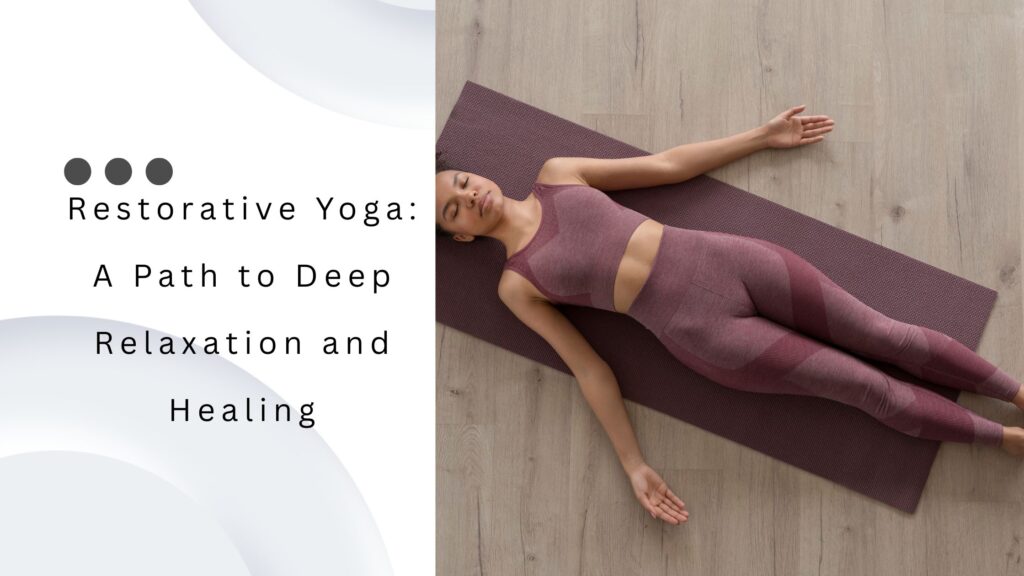In today’s fast-paced world, stress has become a constant companion for many. Whether it’s the pressures of work, personal challenges, or the constant barrage of information, finding moments of peace can seem elusive. This is where Restorative Yoga steps in—a gentle yet profound practice designed to calm the mind, soothe the body, and restore balance.
Restorative yoga is a slow, calming style of yoga designed to promote deep relaxation and reduce stress. It involves holding poses for longer durations, typically with the support of props such as bolsters and blankets, to help the body fully relax. The practice focuses on mindful breathing and releasing physical and mental tension.
Table of Contents
What is Restorative Yoga?
Restorative Yoga is a meditative and therapeutic form of yoga that focuses on passive stretching and deep relaxation. Unlike more vigorous styles like Vinyasa or Ashtanga, restorative yoga emphasizes holding poses for extended periods—typically 5 to 20 minutes—supported by props such as bolsters, blankets, and blocks. This approach allows the body to fully relax, facilitating the activation of the parasympathetic nervous system, often referred to as the “rest and digest” system.
The primary goal of restorative yoga is not to build strength or flexibility but to promote deep relaxation and healing. By slowing down and turning inward, practitioners can release accumulated tension, reduce stress, and cultivate a sense of inner peace.
The Science Behind Restorative Yoga
1. Activating the Parasympathetic Nervous System
The long-held poses in restorative yoga encourage the body to shift from the sympathetic nervous system (the “fight or flight” response) to the parasympathetic system. This transition promotes relaxation, lowers heart rate, and reduces levels of the stress hormone cortisol.
2. Enhancing Sleep Quality
Regular practice of restorative yoga has been shown to improve sleep quality. The deep relaxation achieved through supported poses can help regulate the body’s internal clock, making it easier to fall asleep and stay asleep.
3. Reducing Chronic Pain
For individuals dealing with chronic pain conditions, restorative yoga offers a gentle way to alleviate discomfort. The slow, mindful movements and prolonged holds can help release muscle tension and improve circulation, leading to reduced pain levels.
Restorative yoga provides a safe space to process emotions and cultivate mindfulness. The practice encourages self-awareness and emotional regulation, which can be particularly beneficial for those experiencing anxiety, depression, or emotional trauma.
Key Benefits of Restorative Yoga
- Stress Reduction: By promoting relaxation and calming the nervous system, restorative yoga helps reduce stress and anxiety levels.
- Improved Sleep: The practice aids in better sleep quality by calming the mind and preparing the body for rest.
- Enhanced Flexibility: Gentle stretching in restorative poses can improve flexibility over time without the risk of strain.
- Pain Relief: Regular practice can alleviate chronic pain conditions by releasing muscle tension and improving circulation.
- Emotional Healing: Restorative yoga offers a therapeutic environment for emotional release and healing.
Read More: Vinyasa Yoga: Flow Your Way to Strength, Flexibility & Inner Calm
Read More: Bikram Yoga: Unlock the Power of Heat, Discipline, and Transformation

Common Restorative Yoga Poses
1. Supported Child’s Pose (Balasana)
A foundational pose that encourages deep breathing and relaxation. Kneel on the mat, bring your big toes together, and spread your knees wide. Sit back onto your heels and extend your arms forward, resting your forehead on the mat. Use a bolster or blanket under your chest for added support.
2. Reclining Bound Angle Pose (Supta Baddha Konasana)
Lie on your back and bring the soles of your feet together, allowing your knees to fall open. Place a bolster or pillows under your back and knees for support. This pose opens the hips and promotes deep relaxation.
3. Supported Bridge Pose (Setu Bandhasana)
Lie on your back with your knees bent and feet flat on the floor. Place a block or bolster under your sacrum and allow your hips to rest on it. This gentle backbend opens the chest and relieves tension in the lower back.
4. Legs-Up-The-Wall Pose (Viparita Karani)
Sit next to a wall and lie back, extending your legs up the wall. Place a bolster or blanket under your hips for support. This inversion pose helps reduce swelling in the legs and promotes relaxation.
5. Supported Savasana (Corpse Pose)
The final resting pose of a restorative yoga session. Lie flat on your back with your legs extended and arms by your sides, palms facing up. Use props like blankets or an eye pillow to enhance comfort and encourage deep relaxation.
| Category | Details |
| Definition | A gentle, meditative yoga practice focusing on deep relaxation using props. |
| Main Purpose | Activate parasympathetic nervous system; reduce stress and promote healing. |
| Key Benefits | Stress relief, better sleep, pain reduction, emotional balance, flexibility. |
| Typical Duration of Poses | 5 to 20 minutes per pose |
| Common Props Used | Bolsters, blankets, yoga blocks, straps, eye pillows |
| Ideal Environment | Dim lighting, warm temperature, calming music, aromatherapy |
| Top Poses | Child’s Pose, Supta Baddha Konasana, Viparita Karani, Savasana |
| Who It’s For | Beginners, people with stress, chronic pain, emotional trauma, or insomnia |
| Best Practice Frequency | 2–4 times per week or as needed for relaxation and recovery |
| Special Uses | Prenatal yoga, post-injury recovery, mental health support |
Creating the Ideal Environment for Practice
To fully experience the benefits of restorative yoga, it’s essential to create a conducive environment:
- Lighting: Opt for soft, dim lighting or candles to create a calming atmosphere.
- Temperature: Ensure the room is comfortably warm to facilitate muscle relaxation.
- Sound: Play gentle, soothing music or nature sounds to enhance the meditative experience.
- Aromatherapy: Use essential oils like lavender or chamomile to promote relaxation.
- Props: Gather necessary props such as bolsters, blankets, blocks, and eye pillows to support your practice.
Incorporating Restorative Yoga into Your Routine
Starting a restorative yoga practice doesn’t require a significant time commitment. Even dedicating 20 to 30 minutes a few times a week can yield noticeable benefits. Here’s a simple sequence to get started:
- Supported Child’s Pose: 5 minutes
- Reclining Bound Angle Pose: 5 minutes
- Supported Bridge Pose: 5 minutes
- Legs-Up-The-Wall Pose: 5 minutes
- Supported Savasana: 5 minutes
Focus on your breath throughout the practice, allowing each inhale and exhale to guide you deeper into relaxation.
Restorative Yoga for Specific Needs
Restorative yoga is adaptable and can be tailored to meet various needs:
- Pregnancy: Gentle poses can alleviate discomfort and promote relaxation during pregnancy.
- Chronic Illness: Supports the body’s natural healing processes and boosts energy levels.
- Emotional Trauma: Provides a safe space for emotional release and healing.
- Post-Injury Recovery: Aids in gentle rehabilitation and muscle recovery.
Always consult with a healthcare provider before starting any new exercise regimen, especially if you have underlying health conditions.
Conclusion
In a world that often values productivity over well-being, Restorative Yoga offers a sanctuary of stillness and healing. By embracing this gentle practice, you can cultivate a deeper connection with yourself, reduce stress, and promote overall health. Whether you’re seeking relief from physical discomfort, emotional healing, or simply a moment of peace, restorative yoga provides the tools to restore balance and harmony in your life.
Remember, the journey to wellness begins with a single breath. Take that breath now, and allow restorative yoga to guide you back to your center.
FAQ:
Q. What is restorative yoga and how is it different from other yoga styles?
Ans: Restorative yoga is a gentle, therapeutic style of yoga that focuses on deep relaxation, healing, and stress relief. Unlike more active yoga styles like Vinyasa or Power Yoga, restorative yoga uses props to fully support the body in restful postures held for longer durations. This allows the nervous system to shift into a calm, parasympathetic state, promoting physical and emotional restoration.
Q. What are the benefits of practicing restorative yoga regularly?
Ans: Regular practice of restorative yoga can lead to numerous health benefits including reduced stress, improved sleep quality, enhanced flexibility, and relief from chronic pain. It also supports immune function and fosters emotional balance by calming the mind and relaxing the body. Because it encourages mindfulness and slow, deep breathing, it’s particularly effective for managing anxiety and burnout.
Q. Can beginners do restorative yoga, or is it only for advanced practitioners?
Ans: Absolutely—restorative yoga for beginners is highly recommended. It’s one of the most accessible forms of yoga because it requires no prior experience or flexibility. The use of props like bolsters and blankets helps individuals of all levels fully relax into each pose without physical strain. It’s a perfect starting point for anyone new to yoga or seeking gentle stress relief.
Q. How often should I practice restorative yoga to see results?
Ans: Even practicing restorative yoga just 2–3 times a week can produce noticeable results in stress reduction, sleep quality, and overall well-being. However, daily practice—even for just 15–20 minutes—can deepen the benefits over time. Consistency is key to experiencing the full calming and healing effects of this deeply nourishing practice.
Q. What do I need for a restorative yoga session at home?
Ans: To practice restorative yoga at home, you’ll need a few key props to fully support your body in each pose. Common items include a yoga mat, bolsters or firm pillows, blankets, blocks, and a strap. You can also create a calming environment with soft lighting, relaxing music, and essential oils to enhance the overall experience. The goal is to create comfort and ease, allowing the body to fully relax and restore.
Q. What is restorative yoga?
Ans: Restorative yoga is a meditative and passive style of yoga that encourages you to concentrate on your breath while letting go of tension in the body. Unlike more active yoga practices, restorative yoga involves holding poses, or asanas, for extended periods—usually five minutes or longer.
Q. Who benefits from restorative yoga?
Ans: Restorative yoga is a gentle and accessible practice, especially beneficial for those healing from injuries or managing chronic pain. By fostering deep relaxation and comfort, it supports the body’s natural ability to heal.
Q. What are the disadvantages of restorative yoga?
Ans: It Can Cause Physical Discomfort
In restorative yoga, you fully release muscle control, often lying still with your eyes closed and your body open and exposed. Many poses involve positions where the joints aren’t fully supported in their sockets, which can lead to feelings of physical instability or discomfort.
Q. What is another name for restorative yoga?
Ans: Restorative Yoga
Often referred to as yin yoga, restorative classes utilize props like bolsters, blankets, and blocks to support the body in passive poses. This allows students to receive the full benefits of each posture without any physical effort. A well-guided restorative session can be even more refreshing than taking a nap.
Declaration Note:
We use third-party videos and images on https://yogavidhi.com/ for educational and illustrative purposes. All rights belong to their respective owners. No copyright infringement is intended.



